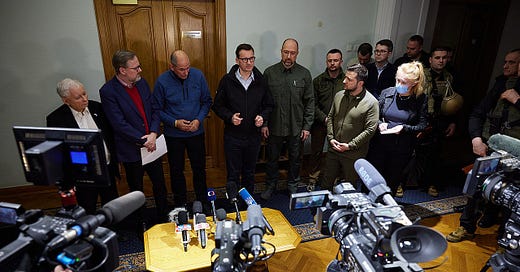
Wars are politics by other means. The fighting is effectively a means of negotiating the terms of the peace. There probably is space for an agreement between Russia and Ukraine, but as long as both sides have reason to believe they can improve their positions, they aren’t likely to agree on a lasting ceasefire.
“Wars can only occur when two nations decide that they can gain more by fighting than by negotiating. War can only begin and can only continue with the consent of at least two nations.”—Geoffrey Blainey, The Causes of War1
“War and peace are not separate compartments. Peace depends on threats and force; often peace is the crystallisation of past force.” Geoffrey Blainey, The Causes of War2
The conflict in Ukraine can be resolved only by an agreement to stop fighting. It’s probably in both Ukraine and Russia’s interests to reach an agreement sooner rather than later. If they knew in advance with certainty what the outcome would be, it would be less costly and save a lot of lives to skip the fighting. Wars are fought in large part because opposing sides don’t agree what the outcome will be. States continue to fight as long as they believe they’re likely to get a better deal by doing so. The open question—which each side is still fighting to determine—is just what that final deal will be.
The costs of the war are high for both sides. Ukraine’s people are dying, and it’s cities are being destroyed. Russian soldiers are dying, and its economy is being devastated. It’s not obvious which side’s position is likely to improve the longer the war continues. Even if Ukraine’s military collapses, it’s hard to see how Russia could control the country except at great cost. It’s also hard to see how Ukraine could force Russian forces out of the country. Some kind of uneasy, partitioned peace is probably where we’re headed.
But it could take some time to get there. There aren’t many short wars. Wars that are over quickly tend to end because of the decisive defeat of one side. A ceasefire was declared in the 2008 war between Russia and Georgia just 11 days after war started, but that was because Georgia was clearly unable to expel Russian forces from South Ossetia and Abkhazia. Stalemates—like the one we seem headed to—take longer to determine. Many wars grind on for years.


In this case, both Russia and Ukraine may reasonably believe they can improve their position by continuing to fight. Putin may believe that when the Ukrainian solidifies, Russia will be able to capture Kyiv and consolidate its gains in Eastern Ukraine. By continuing to target civilians Russia could convince Ukrainians it would be better to accept Russia’s terms. Zelensky meanwhile may calculate that the longer Ukraine demonstrates it can hold out while Russia suffers under punishing sanctions, the better Ukraine’s negotiating position will be. Both sides may want to see how things play out before committing to a deal they don’t like.
Russia and Ukraine appear to be in constant talks now, with both sides saying they’re making progress. Ukrainian negotiator Mykhailo Podolyak told ABC News that the negotiations are “absolutely real” but may take “months.” A deal that could be acceptable to all sides would probably include
A commitment from Ukraine to remain neutral between Russia and NATO
Recognition of the independence or Russian annexation of Crimea and the Donbas region
Russian withdrawal from other parts of Ukraine
Lifting economic sanctions on Russia
Credible international guarantees of Ukraine’s future security
Ukraine should not have to sign such a deal. It would be accepting illegitimate claims under duress. There’s no guarantee Ukrainians would agree to an imposed peace under these terms. But such an agreement might also save a lot of Ukrainian lives, and Zelensky may be able to sell it as a compromise worth making. It may be true, as Cicero wrote, that an unjust peace is better than a just war.
Whatever happens, negotiations will take some time. How long will likely depend on how optimistic each side is about its chances of improving its negotiating position. Russia is paying an enormous price for its invasion, but—as I wrote last week—Putin’s control over the Russian state may insulate him from the most serious consequences of his actions. He may even see an advantage in maintaining an unresolved “frozen conflict” in Ukraine. For Ukraine, agreeing to terms with Russia would be a bitter pill, even if it may be better for Ukraine in the long run. Metaculus forecasters currently estimate there’s a 75% chance of a bilateral ceasefire in 2022.
My Forecast
8% chance of a bilateral ceasefire agreement in Ukraine before June
54% chance of a bilateral ceasefire agreement in Ukraine in 2022
Arvid Bell and Dana Wolf posted an excellent analysis of the prospects for a ceasefire agreement a couple of weeks ago here. If you enjoyed this post from Telling the Future, you can support my work by sharing it with others.
Geoffrey Blainey, The Causes of War, 3rd Ed. (Simon & Schuster, 1988): 159.
Geoffrey Blainey, The Causes of War, 3rd Ed. (Simon & Schuster, 1988): 173.



